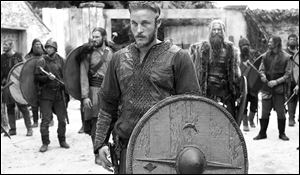
TELEVISION
History to bring Vikings back to life in new series
2/25/2013
Travis Fimmel stars as Ragnar Lothbrok in the History channel’s first scripted series ‘Vikings.’
They are akin to NASA astronauts or the pioneers of Silicon Valley — except they lived 1,300 years ago, and it was the high seas that demanded navigation, not outer space or the Internet.
The Vikings, who like those later explorers were driven by curiosity and armed with the latest innovations, also set out to conquer an uncharted world, the breadth and possibilities of which could not be entirely conceived.
Their struggles, both internal and external, are extravagantly brought to life in Vikings, the History channel’s ambitious nine-part drama series from Michael Hirst, creator of The Tudors. It has its premiere on Sunday. Propelled by the tale of the legendary Norse adventurer Ragnar Lothbrok, his family, and his band of followers, the lushly produced, effects-enhanced series dazzles with evocative scenery and dynamic displays of superherolike derring-do and physical stamina.
In this, its first scripted episodic regular series, History is following up on the spectacular ratings success of its scripted Hatfields & McCoys miniseries last spring and at the same time reaching out to an action-oriented young male demographic weaned on spectacular, sophisticated gaming.
“We’re putting everything behind it that we possibly can,” said Nancy Dubuc, president for entertainment and media for History’s parent, A&E Networks. “This is a topic that has always resonated with our viewers through our historical documentaries. Hopefully it’s very appealing to a core young male audience — I think there are some parallels to some of the video games that are being played today by young men.”
Dubuc said “two stars aligned” when the subject matter turned out to be a passion project for Hirst, who, besides Showtime’s popular series The Tudors and The Borgias, has to his credit the well-received 1998 film Elizabeth and other historical dramas. He had an interest in the Vikings dating back to a script he wrote about the ninth-century English monarch Alfred the Great, who successfully fought off those seaborne invaders.
For the elaborate History project, Hirst immersed himself in what had been written about Viking culture — basically documentation by outside observers since theirs was an illiterate society. He found the material limited and biased.
“They’re always the guys who break in through the door, slash up your house, and rape and pillage for no good reason, except that they enjoy the violence,” he said. “I wanted to tell the story from the Vikings’ point of view, because their history was written by Christian monks, basically, whose job it was to exaggerate their violence.”
Not that brawn, brutality, and blood don’t play a central role. Well-muscled bodies abound, and battles are frequent, vivid, and skillfully choreographed. When the Vikings themselves aren’t being beheaded or gruesomely punished for running afoul of the local chieftain (Gabriel Byrne), Lothbrok (the Australian actor Travis Fimmel), and his men are leading savage slaughters on foreign villages and monasteries. Women in the cast (led by Katheryn Winnick as Lothbrok’s wife) can also handily wield their shields.
Despite History’s mantle of preserving and purveying an accurate picture of the past, hewing to the letter of historical accuracy wasn’t possible in the case of a dramatic series based on fragmented documentation, hence a large degree of dramatic license was employed.
“I especially had to take liberties with Vikings because no one knows for sure what happened in the Dark Ages,” Hirst said. “Very little was written then.” The bottom line, he explained, was: “We want people to watch it. A historical account of the Vikings would reach hundreds, occasionally thousands, of people. Here we’ve got to reach millions.”
Precise accuracy proved evasive on many levels. The production designer, Tom Conroy, relied upon Scandinavian museums for many of his visual references but still found that he had to piece a lot of things together.
While metal works from the Vikings’ post-Iron Age culture have survived, Conroy said, he was hard put to replicate authentic fabrics and woods. One of the biggest challenges he faced, he added, was improvising lighting sources for Viking homes and halls, which had no windows, making engaging photography of a strictly realistic interior setting impossible.
The production also designed two 56-foot-long Viking ships and commissioned custom furniture from India, where open-air markets provided many of the series’ props, including metal goblets and other everyday items.
The role of high technology — in this case a matter of a crude compass and ships capable of navigating violently churning oceans as deftly as shallow inland rivers — is a particularly germane facet of Vikings, lending the series an unexpected resonance in today’s society grappling with the cyberfrontier.
“The Vikings had no pottery, they didn’t read, they didn’t write,” Hirst said. “At the same time they were way ahead of other people in boatbuilding and navigation. They discovered America hundreds of years before Columbus. They had the technology to build a boat, but it wasn’t about the boat. It was about: Where is it going to take you?"
Vikings, with a budget reported at $40 million, represents History’s biggest series investment to date, and Dubuc said she is optimistic it will reach beyond the channel’s core male audience and pull in female viewers too.
“This is the intersection of what really works for us, when you take a big what-you-think-you-know title and combine it with: Oh, gee, I didn’t know that,” she said. “I expect it to outperform any other unscripted or documentary series that we’ve ever done, but I’m realistic about it against Hatfields & McCoys.”